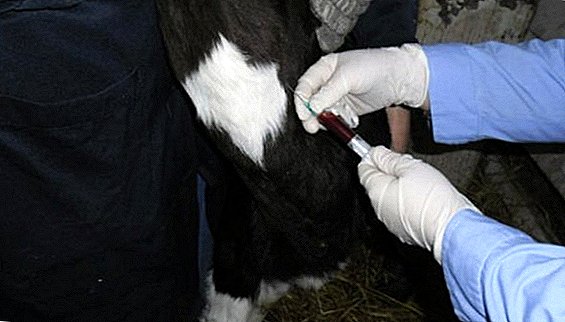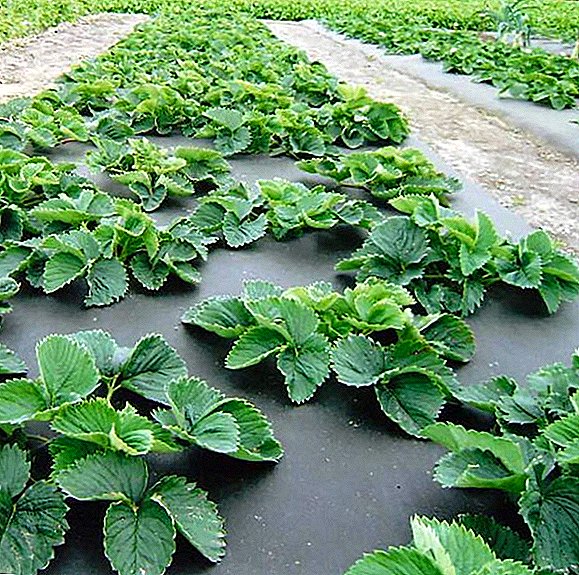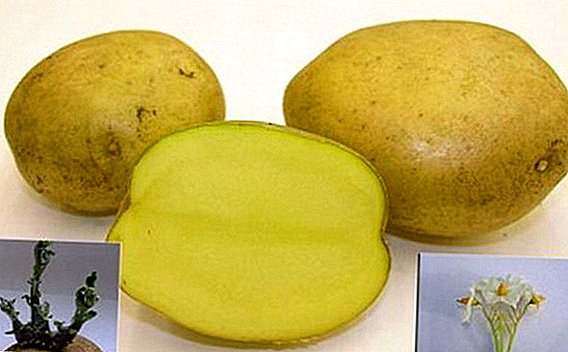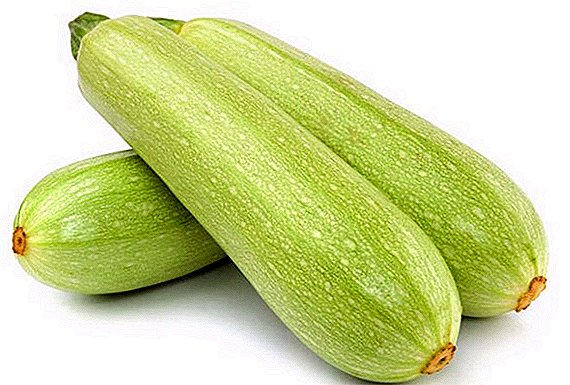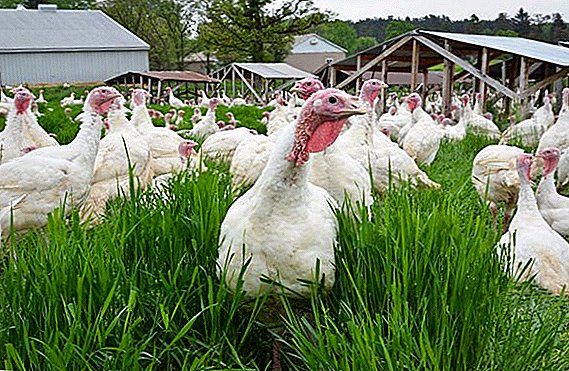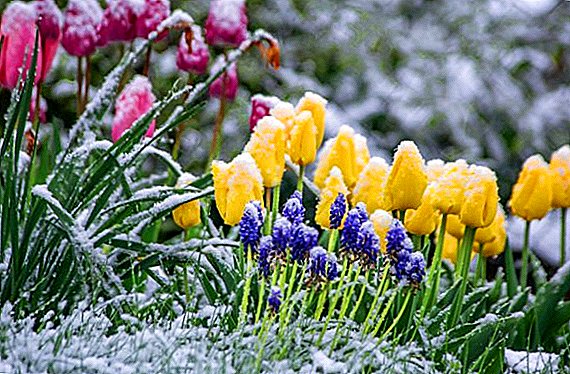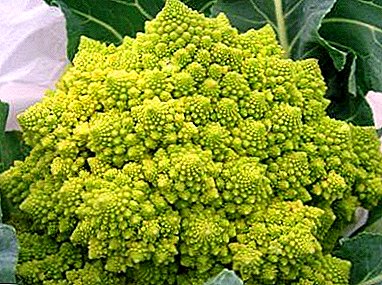
Its shape is compared with coral, sea shell, Christmas tree, the taste is called delicious and exquisite. And the nutrients contained in the cabbage Romanesco, make it one of the most healing garden crops.
Growing cabbage of this type is associated with a number of difficulties, especially for novice gardeners, but the aesthetic and culinary pleasure from the dishes from it is worth the effort.
In the article you will read what kind of plant it is, how to grow it properly and how to achieve a good harvest.
History of
The authentic history of the appearance of Romanesco cabbage is not known. According to one version of it, ancient Etruscans grew it in the 1st century BC. uh ... However on the vegetable market, this cabbage appeared only in the 90s of the twentieth century. It is believed that it is the result of crossbreeding broccoli and cauliflower by Italian breeders, although there is no exact confirmation of this.
Description
Romanesco (Brassika oleracea var botrytis), also known as Romanesque broccoli, Roman and coral cabbage, in the botanical classification is related to the main genus Cauliflower Cruciferous.
This is a one-year garden crop with a lemon-green dome-shaped or pyramidal head of an aster-flower from densely arranged pyramid inflorescences. Large fruit - from 350 g to 2.0 kg. The head is framed by large, long, dark green or blue-green, weakly dumb, leaves collected in a raised rosette. Stalk powerful, high - up to 1 meter.
With proper cultivation, the average yield is 1.6-4.2 kg / m². Tastes assessed as good and high.
In the State Register of Breeding Achievements there are four Romanesco cauliflower subsorts recommended for cultivation in all regions of Russia:
- Poinauderde - medium early, large-fruited (up to 1.5 kg).
- Emerald Cup - medium early, with small fruits (0.35-0.5 kg).
- Veronica F1 - mid-season, with fruits 1.5-2.0 kg.
- Pearl - medium late, with a head of an average size up to 0.8 kg.
Even among the gardeners are popular not included in the register varieties: Amphora F1, Gregory, Romanesco Natalino, Snappy Turtle.
A photo
You will see a photo of Romanesco cabbage (Romano):





Difference from other species
The main distinguishing feature of Romanesco cabbage is the complex structure of the fruit head. Small, curled flowers in a spiral arranged in a dense pyramid inflorescence. The pyramids, in turn, curl up into a spiral to form a large heading. Mathematicians call this form a fractal spiral.
Romanesco tastes different from cauliflower and broccoli cabbage. Her young inflorescences have a pronounced nut-creamy sweetish, delicate taste. But most importantly, Romanesco is much richer than other types of cabbage in terms of the content of useful chemical elements.
Advantages and disadvantages
The main advantage of Romanesco is a unique composition, which includes:
- water;
- fiber;
- vitamins A, C, groups B, E, K;
- carotene;
- trace elements (calcium, potassium, zinc, magnesium, manganese, iron, phosphorus, fluorine, sodium, copper, selenium);
- folic acid;
- polysaturated fatty acids;
- amino acids;
- flavonoids;
- sulforofan, glucosinolates and isothiocyanates;
- antioxidants.
 Romanesco has pronounced healing properties. It has anti-inflammatory, antiviral, antibacterial and antimicrobial action. Excretes toxic substances and carcinogens from the body. Beneficial effect on the central nervous system. At the same time the plant belongs to easily digestible, low-calorie, dietary products. The caloric value of 100 grams is only 30 kcal, which makes Romanesco cabbage attractive for people seeking to lose weight.
Romanesco has pronounced healing properties. It has anti-inflammatory, antiviral, antibacterial and antimicrobial action. Excretes toxic substances and carcinogens from the body. Beneficial effect on the central nervous system. At the same time the plant belongs to easily digestible, low-calorie, dietary products. The caloric value of 100 grams is only 30 kcal, which makes Romanesco cabbage attractive for people seeking to lose weight.
Gardeners refer to the advantages of high ornamental plants. Often it is planted in flower beds, combining with more stunted flowering and decorative leafy crops.
Romanesco has only one drawback - Culture is extremely sensitive to temperature and humidity. In many regions of Russia with an unpredictable continental climate, growing this type of cabbage is quite problematic.
Care and cultivation
The cultivation of Romanesco cabbage is similar to the cultivation of cauliflower and Brussels sprouts. When planting use two methods - seedling and sowing seeds in open ground.
Attention: off-seed method is possible only in the southern regions of Russia.
- Acquisition of seed
Seeds come on sale as cauliflower varieties (Veronica cauliflower, Pearl, etc.). The cost of a bag of seeds (25 g) in Moscow and St. Petersburg within 10-15 rubles.
- Landing time
Seeds in open ground are sown after the threat of return frost has passed:
- early maturing varieties - from mid-March to mid-April;
- mid-season - in April;
- late - from the middle of May.
Seedlings planted :
- early varieties - from late April to mid-May;
- mid-season - from mid-May to mid-June;
- late - from mid-June to mid-July.
- Choosing a landing site
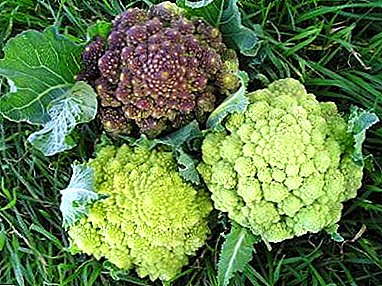 Romanesco should not be planted after turnips, radishes, radishes, swede, lettuce. After any types of cabbage, in order to avoid disease, Roman cabbage is planted not earlier than in 3-4 years. Potatoes are considered to be the best predecessor, the crop feels good in areas where carrots, onions, tomatoes, cucumbers, legumes, cereals, and beets have grown. The place should be sunny and always wet.
Romanesco should not be planted after turnips, radishes, radishes, swede, lettuce. After any types of cabbage, in order to avoid disease, Roman cabbage is planted not earlier than in 3-4 years. Potatoes are considered to be the best predecessor, the crop feels good in areas where carrots, onions, tomatoes, cucumbers, legumes, cereals, and beets have grown. The place should be sunny and always wet. - The soil
The soil begins to prepare in the fall. When digging make manure (2 buckets per 1 m²), which will have time to perepret during the winter, and complex mineral fertilizers containing molybdenum, boron, copper.
For Romanesco, friable alkaline soils are preferred - black earth or loamy black earth. A land with a high acidity index is limeed or wood or dolomite ash (200-400 g / m²) is added to it. If you failed to prepare the beds in the autumn, you can do it in early spring, as soon as the soil thaws.
- Landing
Romanesco seeds are very small, so the soil is pre-leveled, moisturized. If possible, evenly pour out the seeds, sprinkle 1-2 cm layer of earth on top. Seedlings are planted in pre-prepared wells. Early varieties are planted at the age of 60 days, middle ripening - 40, late - 35 days. With any method of planting maintain a distance between plants of 60 cm, between rows - 50 cm.
- Temperature
Temperature conditions - the main requirement for growing Romanesco. Not "guessing" with the time of planting, you can go without a crop. Bud formation and flowering occurs only at a temperature of + 15-20 ºC.
When cultivating late varieties, sowing of seeds and planting of seedlings is calculated in such a way that the formation of the head falls on a period with a cool night temperature, for most regions this is the end of August-September.
- Watering
Cabbage requires regular abundant watering, but without water stagnation on the soil surface. At a temperature of + 15-20 ºC, it is enough to water the beds once every 2-3 days, in hot weather - every day.
- Top dressing
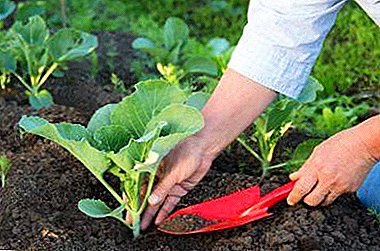 Top dressing bring 3 times during the growing season:
Top dressing bring 3 times during the growing season:- After 7-10 days after the emergence of seedlings or after transplanting to the open ground, fertilize the young shoots with rotted manure.
- After 14 days, a glass of wood ash is poured under each plant and nitrophos is applied at the rate of 300 g / m².
- During the beginning of the formation of the head of a young plant, it is fed with complex fertilizer, for the preparation of which 30 g of ammonium nitrate, 80 g of superphosphate, 20 g of potash fertilizer are dissolved in a bucket of water.
Important! The aisles are loosened after each watering, in the rains to a depth of 10-12 cm, in drought by 4-6 cm, after which the soil is mulched.
- Harvesting
Harvest starts from late August to mid-October, depending on the variety and weather conditions. The collection is carried out in the morning, in dry weather, before the inflorescences are heated in the sun. You can not overdo ripe cobbles on the vine, they will lose juiciness, taste and healthy qualities.
- Storage
Tender inflorescences of Romanesco can be kept in the refrigerator for no more than 15 days. For long-term storage, heads, disassembled into small pyramids, are frozen. With this method all useful substances and vitamins are saved.
Diseases and pests
Among the pests that plague Romanesco:
- aphid;
- cruciferous flea;
- cabbage butterfly caterpillars;
- Medvedka;
- cabbage covert;
- cabbage fly
To fight insects, insecticides are used.
Roman cabbage is subject to all diseases peculiar to cauliflower:
- blackleg;
- mosaic;
- Alternaria;
- kila;
- mucous bacteriosis.
Prevention of various problems
For prevention you can take the following measures:
- from fungal, viral diseases, before planting, sprinkle boiling water or a dark pink manganese solution before planting;
- so that the tender inflorescences do not burn with the sun, heads crown, tying the upper leaves above them;
- good results are obtained by planting next to cabbage beds of repellent plants (garlic, marigold, marigold, dill).
Cabbage Romanesco - a kind of challenge for enthusiasts. To grow it on the shoulder only an experienced gardener. Any failure to comply with agricultural technology, bad weather, the attack of pests leads to a loss of the crop.


 Romanesco should not be planted after turnips, radishes, radishes, swede, lettuce. After any types of cabbage, in order to avoid disease, Roman cabbage is planted not earlier than in 3-4 years. Potatoes are considered to be the best predecessor, the crop feels good in areas where carrots, onions, tomatoes, cucumbers, legumes, cereals, and beets have grown. The place should be sunny and always wet.
Romanesco should not be planted after turnips, radishes, radishes, swede, lettuce. After any types of cabbage, in order to avoid disease, Roman cabbage is planted not earlier than in 3-4 years. Potatoes are considered to be the best predecessor, the crop feels good in areas where carrots, onions, tomatoes, cucumbers, legumes, cereals, and beets have grown. The place should be sunny and always wet. Top dressing bring 3 times during the growing season:
Top dressing bring 3 times during the growing season:

